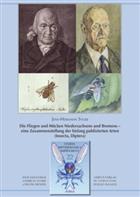Die Fliegen und Mücken Niedersachsens und Bremens: eine Zusammenstellung der bislang publizierten Arten (Insecta, Diptera) (Studia Dipterologica Supplement 22)
- Series : Studia Dipterologica - Supplement
Volume: 22 - Publisher : Ampyx-Verlag
- Illustrations : col + b/w photos
Our customers have not yet submitted a review for this title - click here to be the first to write a review
Description:
Text German. To date a summary of the Diptera known from Lower Saxony and Bremen has not been compiled. Consequently, this work has evaluated 832 publications in order to determine the currently known Diptera of Lower Saxony and Bremen. 4017 valid species from 109 families are published. The records of 193 of these species are considered to be doubtful. These are (a) historical records that could not be correctly determined with the literature available at that time, or (b) records of species from far outside their previously known distribution area that were listed without further comment.
Apart from these dubious records, a total of 3824 species of Diptera have been found. From the city-state of Bremen only 1066 Diptera species are known, from Lower Saxony 3673. Most of the published records would not meet strict evaluation criteria. For each species a complete source list has been separately compiled for Lower Saxony and Bremen. This results in the first comprehensive bibliography of the Diptera of Lower Saxony and Bremen.
A short summary of more than 200 years of history of dipterological research in Lower Saxony and Bremen has been compiled. In 1794 a fruit fly (Drosophilidae) from Braunschweig was described – this is the first published record of a dipteran from Lower Saxony. Faunistic observations in the 19th and early 20th centuries in northern Lower Saxony and Bremen were summarized by the important dipterist Otto Kröber. Diseases caused by Diptera have resulted in research on individual fly species in Lower Saxony and Bremen. For example the devastating malaria epidemics in northern Lower Saxony were due to the mosquito Anopheles (Culicidae); the "Leinemücke" (Simuliidae) led to cattle dying; biting midges (Ceratopogonidae) spread bluetongue disease and phytophagous Diptera caused loss of yield in agriculture. Ecological research in the second half of the 20th century, especially in forests and on arable land in Lower Saxony, yielded a significant increase in knowledge. Flies and midges were largely untouched by nature conservation activities. They are still not considered important in nature conservation work in Lower Saxony and Bremen! An overview of the sparse current research is provided by profiles of current dipterologists in Lower Saxony and Bremen.
Only the species lists of robber flies (Asilidae) and thick-headed flies (Conopidae) are nearly complete. Records of the remaining 58 species-rich families are incomplete or fragmented. Overall, the knowledge of the Diptera of Lower Saxony and Bremen is insufficient. At most half of the expected species have been recorded and published from Lower Saxony and Bremen. Currently Diptera are not systematically recorded in Lower Saxony and Bremen. Only a few private researchers are sporadically investigating selected fly families. This is worrying, because flies and midges are the most species rich group in Lower Saxony and Bremen!
Other titles from the series : Studia Dipterologica - Supplement
Click to view all titles in this series...
Phylogeny of the subfamily Ilytheinae (Diptera: Ephydridae) with special
Hollmann-Schirrmacher, V.
Price £22.00
The Porricondylinae (Diptera: Cecidomyiidae) of Sweden with notes on
Jaschhof, M.; Jaschhof, C.
Price £130.00
The Wood Midges (Diptera: Cecidomyiidae: Lestremiinae) of Fennoscandia and
Jaschhof, M.; Jaschhof, C.
Price £120.00
Diptera Stelviana. A dipterological perspective on a changing alpine landscape.
Ziegler, J. (Ed.)
Price £115.00










